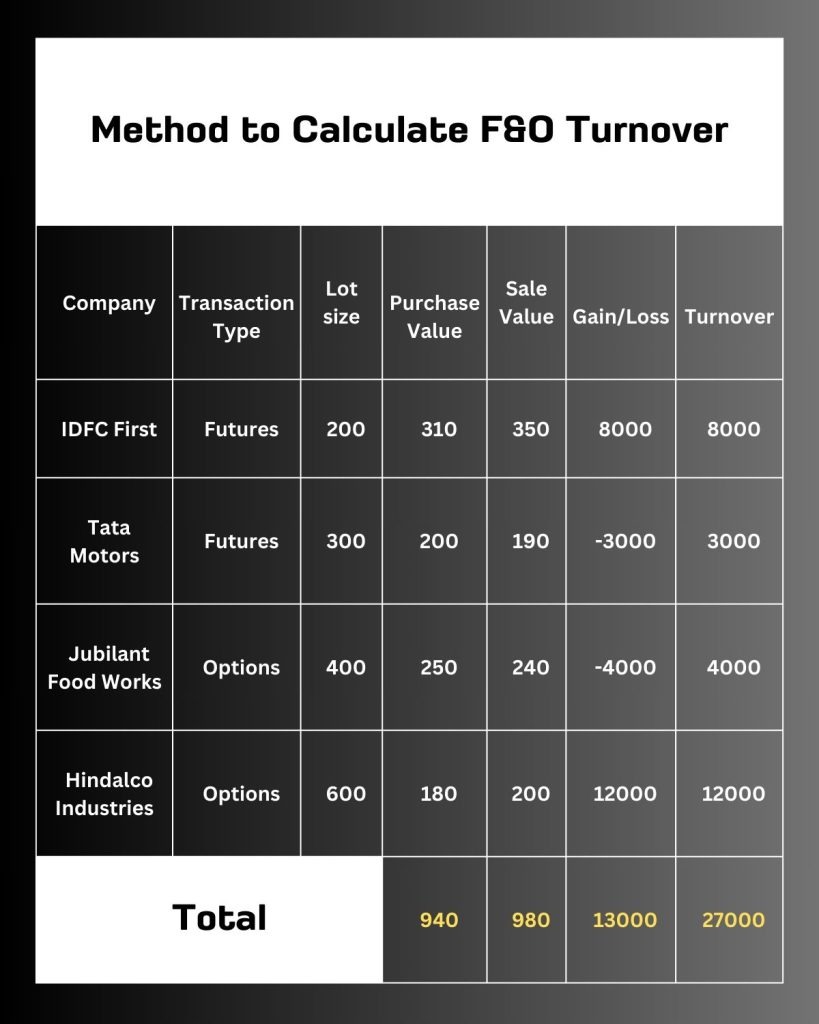F and O – Futures and Options is a non speculative business which are types of financial derivatives used in trading:
- Futures are contracts to buy or sell an asset at a predetermined price at a specified future date.
- Options are contracts that give the buyer the right, but not the obligation, to buy or sell an asset at a predetermined price within a specific time period.

What kind of income is F&O?
F&O revenue is a non-speculative business income which means it is reported under the head ‘Business’ in Income Tax Return.
Which ITR Form required to file for F&O income?
To report Futures and Options income, file:
- ITR-3: If individuals and HUFs have income from a proprietary business or profession.
- ITR-4: If individuals, HUFs, and firms (other than LLPs) have opted for the presumptive taxation scheme.
How tax is charged on F&O?
Profit and loss from F&O are taxable:
- For Individual or HUF: As per Slab Rate
- For Firm / LLP: 30%
- For Company: 22% or 25% or 30%
Click here to know the slab rates.
How to calculate Turnover in F&O Trading?
Calculating the turnover for Futures and Options (F&O) trading is essential for tax purposes, particularly to compute the Absolute Turnover. This involves summing up all the positive and negative differences from your trades.
Steps to Calculate F&O Turnover
- Calculate to determine whether you made a Profit and Loss for Each Trade
- Sum up all the profits from your F&O trades.
- Sum up all the losses from your F&O trades (take the absolute value, i.e., consider them as positive for turnover calculation).
- To get the Absolute Turnover add the sum of positive differences to the absolute sum of negative differences.
Formula
Absolute Turnover = Profits + Absolute Losses
For Example

Here,
Sum of profits = 8,000 + 12,000 = 20,000
Sum of absolute losses = 3,000 + 4,000 = 7,000
Absolute Turnover = 20,000 + 7,000 = 27,000
Expenses can be claimed
F&O traders can deduct business expenses from their F&O income, even if they incur a loss. Eligible expenses include:
- Brokerage fees.
- Interest on Borrowed Capital.
- Commissions.
- Subscriptions.
- Phone and internet bills.
- Any expense incidental to this business.
Ensure that the expenses are directly related to the business, keep proper records, and prefer digital payments over cash.
Treatment of F&O Losses
- If loss in F&O then can be set off against other normal income in the same.
- Set off from another business & Profession.
- Set off from House Property/ Capital gain / Other Source.
- Salary cannot be set off the F&O loss.
- Loss can be carried forward upto 8 assessment years. But carry forward loss can only be set off from non speculative business (any business).
Tax Audit in F&O Trading
Trading Turnover upto 3 Cr: Tax audit is applicable if the profit or loss from F&O trading is less than 6% of the turnover, and you have opted out of presumptive taxation in any of the last 5 years, with total income exceeding the basic exemption limit.
Between 3 Cr and 10 Cr: Tax audit is not required if more than 95% of transactions are conducted digitally.
Trading Turnover upto 10 Cr: If receipt & Payment are in other than cash of 95% and turnover is upto 10 Cr then audit is not mandatory.
FAQs
Deduction and exemption available on F&O trading income like 80C, 80D, HRA, home loan etc under old regime.
The due date for filing ITR is 31st July of the assessment year, if no tax audit is applicable as per Section 44AB of the Income Tax Act.
Even if there is a loss from F&O trading, it is mandatory to file Income Tax Return (ITR) using Form ITR-3 or ITR-4 within the due date.
Losses can be carried forward to future years for set-off against future profits.